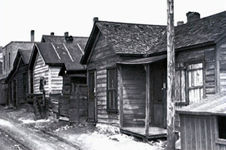the cabbage patch
108 south arizona street | butte, montana
history
This small group of shanties are all that remains of the Cabbage Patch, a shanty town of the 1800’s in Butte. The “Patch” was home to bootleggers, drunks, prostitutes, poor families, newly arrived immigrants, widows with children, criminals, and other down-on-their luck residents. The name Cabbage Patch originated from the predominant diet of its inhabitants, cheap cabbage.
Construction is truly vernacular, using available materials, scavenged or stolen from waste piles, mine yards, and elsewhere. In 1916, the Cabbage Patch extended approximately from Arizona Street on the west to Oklahoma St. on the east, and from Galena (and its extension) on the north to Platinum or Porphyry on the south. Most of the buildings – more than 200 – were razed in 1940-41 to make way for Silver Bow Homes, the ranks of low-income apartments that still stand south of Mercury Street. At about the same time, the buildings here were converted to garages, with addition of flooring and large garage doors.
When used as residences, these places had dirt floors, and no electricity, running water, or sewer systems. Important original elements include scraps of linoleum and loose fabric used as wallpaper and insulation, and pressed tin and wood timber walls.
Why should these humble abodes be preserved? Simply because with all of Butte’s rich and varied, these buildings represent the harsh lives and daily struggles to survive of so many of Butte’s residents. It is important to show both sides of life in Butte’s past.
books, articles, news features, and more
Montana Moment Feature from NBC Montana
Butte Archives interview with author, Jacob Sorich
















